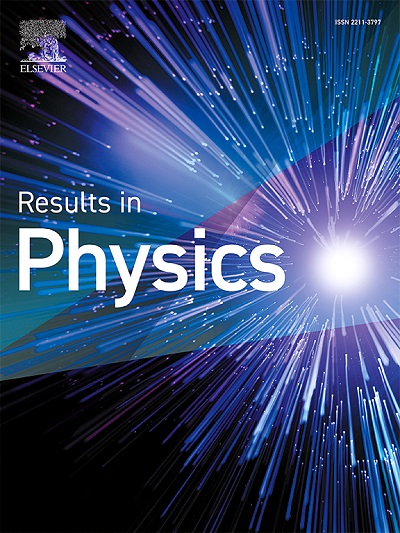Chaotic analysis and a damped oscillator solitary wave structures to the generalized reaction Duffing model
IF 4.4
2区 物理与天体物理
Q2 MATERIALS SCIENCE, MULTIDISCIPLINARY
引用次数: 0
Abstract
The aim of this research is to obtain soliton solutions for the generalized reaction Duffing model, a framework that generalizes many important models that illustrate key phenomena in science and engineering. In contrast to regular harmonic motion, this equation describes the motion of a damped oscillator with a more complex potential. We used the Kumar–Malik method in this work to obtain analytical solutions for the generalized reaction Duffing model, which is the first time this method has been used to extract soliton solutions in this particular setting. The equation is first reformulated as a nonlinear ordinary differential equation using traveling wave transformation. The approach proves particularly effective in handling nonlinear partial differential equations, yielding hyperbolic, Jacobi elliptic, trigonometric, and exponential function solutions under appropriate parameter constraints. A variety of innovative solutions emerge, including periodic wave solutions, dark compacton waves, kink waves, singular kink waves, bright solitons, breather waves, and singular-shaped solitons via the Kumar–Malik method. The solutions are then shown visually to demonstrate the wave behavior under various conditions. Our findings enhance the comprehension of the Duffing equation’s behavior across different physical contexts. The research uses extensive 2D and 3D graphic plot solutions of the proposed solutions for a better graphical understanding of the physical perimeters of solutions and proves the feasibility of the proposed method in solving complex nonlinear equations. The Chaotic analysis has also been discussed by perturbation term and initial conditions. It is important to note that the proposed methods are competent, credible, and interesting analytical tools for solving nonlinear partial differential equations. In addition, these solutions represent a valuable resource for the understanding of the complex behavior of physical systems, as well as for inspiring future research.
广义反应Duffing模型的混沌分析和阻尼振子孤波结构
本研究的目的是获得广义反应Duffing模型的孤子解,Duffing模型是一个概括了许多重要模型的框架,这些模型说明了科学和工程中的关键现象。与普通谐振运动相反,这个方程描述了具有更复杂势的阻尼振荡器的运动。本文采用Kumar-Malik方法获得了广义反应Duffing模型的解析解,这是该方法首次用于提取这种特殊情况下的孤子解。首先利用行波变换将方程重新表述为非线性常微分方程。该方法在处理非线性偏微分方程时特别有效,可以在适当的参数约束下得到双曲、Jacobi椭圆、三角和指数函数的解。通过Kumar-Malik方法,出现了各种创新的解,包括周期波解、暗紧波、扭结波、奇异扭结波、亮孤子、呼吸波和奇异形孤子。然后将解直观地显示出来,以演示各种条件下的波动行为。我们的发现增强了对Duffing方程在不同物理环境下的行为的理解。本研究广泛使用了所提出的解的二维和三维图形解,以便更好地从图形上理解解的物理周长,并证明了所提出的方法在求解复杂非线性方程方面的可行性。本文还从扰动项和初始条件两个方面讨论了混沌分析。值得注意的是,所提出的方法是解决非线性偏微分方程的有效、可靠和有趣的分析工具。此外,这些解决方案为理解物理系统的复杂行为以及启发未来的研究提供了宝贵的资源。
本文章由计算机程序翻译,如有差异,请以英文原文为准。
求助全文
约1分钟内获得全文
求助全文
来源期刊

Results in Physics
MATERIALS SCIENCE, MULTIDISCIPLINARYPHYSIC-PHYSICS, MULTIDISCIPLINARY
CiteScore
8.70
自引率
9.40%
发文量
754
审稿时长
50 days
期刊介绍:
Results in Physics is an open access journal offering authors the opportunity to publish in all fundamental and interdisciplinary areas of physics, materials science, and applied physics. Papers of a theoretical, computational, and experimental nature are all welcome. Results in Physics accepts papers that are scientifically sound, technically correct and provide valuable new knowledge to the physics community. Topics such as three-dimensional flow and magnetohydrodynamics are not within the scope of Results in Physics.
Results in Physics welcomes three types of papers:
1. Full research papers
2. Microarticles: very short papers, no longer than two pages. They may consist of a single, but well-described piece of information, such as:
- Data and/or a plot plus a description
- Description of a new method or instrumentation
- Negative results
- Concept or design study
3. Letters to the Editor: Letters discussing a recent article published in Results in Physics are welcome. These are objective, constructive, or educational critiques of papers published in Results in Physics. Accepted letters will be sent to the author of the original paper for a response. Each letter and response is published together. Letters should be received within 8 weeks of the article''s publication. They should not exceed 750 words of text and 10 references.
 求助内容:
求助内容: 应助结果提醒方式:
应助结果提醒方式:


